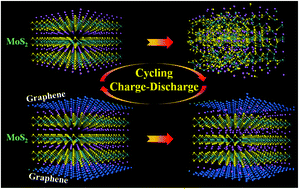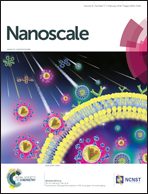The capacity fading mechanism and improvement of cycling stability in MoS2-based anode materials for lithium-ion batteries†
Abstract
Two-dimensional (2D) layered MoS2 nanosheets possess great potential as anode materials for lithium ion batteries (LIBs), but they still suffer from poor cycling performance. Improving the cycling stability of electrode materials depends on a deep understanding of their dynamic structural evolution and reaction kinetics in the lithiation process. Herein, thermodynamic phase diagrams and the lithiation dynamics of MoS2-based nanostructures with the intercalation of lithium ions are studied by using first-principles calculations and ab initio molecular dynamics simulations. Our results demonstrate that the continuous intercalation of Li ions induces structural destruction of 2H phase MoS2 nanosheets in the discharge process that follows a layer-by-layer dissociation mechanism. Meanwhile, the intercalation of Li ions leads to a structural transition of MoS2 nanosheets from the 2H to the 1T phase due to the ultralow transition barriers (∼0.1 eV). We find that the phase transition can slow down the dissociation of MoS2 nanosheets during lithiation. The result can be applied to explain extensive experimental observation of the fast capacity fading of MoS2-based anode materials between the first and the subsequent discharges. To suppress the dissociation of MoS2 nanosheets in the lithiation process, we propose a strategy by constructing a sandwich-like graphene/MoS2/graphene structure that indicates high chemical stability, superior conductivity, and high Li-ion mobility in the charge/discharge process, implying the possibility to induce an improvement in the anode cycling performance. This work opens a new route to rational design layered transition-metal disulfide (TMD) anode materials for LIBs with superior cycling stability and electrochemical performance.


 Please wait while we load your content...
Please wait while we load your content...